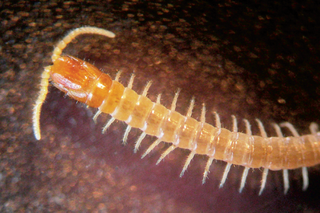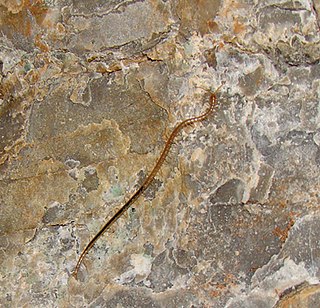
Himantariidae is a monophyletic family of centipedes in the order Geophilomorpha and superfamily Himantarioidea, found almost exclusively in the Northern Hemisphere. The number of leg-bearing segments in this family varies within as well as among species and ranges from 47 to 181. These centipedes are very elongated with a high mean number of trunk segments and great variability in this number within species. The maximum number of legs recorded in this family appears in the species Chomatobius bakeri. The minimum number of legs recorded in this family appears in the species Garriscaphus oreines, This family contains these genera:

Geophilus is a large, heterogeneous genus of soil centipedes in the family Geophilidae largely considered to be synonymous with Brachygeophilus. It is a mostly holarctic genus characterized by a claw-shaped ultimate pretarsus, anterior porefields, complete or nearly complete coxo-pleural sutures at the prosternum, and incomplete chitin-lines. Centipedes in this genus range from 1 cm to 8 cm in length. The generic name first appeared in Brewster's Edinburgh Encyclopaedia in 1814 as Geophilus electricus.

Tygarrup is a genus of centipedes in the family Mecistocephalidae, found mainly in southeast Asia and from the Seychelles to Hawaii. Although species in this genus can have either 43 or 45 leg-bearing segments, most of these species have 45 leg pairs. An undescribed Tygarrup species found in the Andaman Islands has 43 leg pairs. Centipedes in this genus range from 2 cm to 6 cm in length. Tygarrup javanicus is one of the smallest of the mecistocephalid species and has become an invasive in greenhouses in Europe.

Ethmostigmus is a genus of centipedes in the family Scolopendridae found in Africa, Asia, and Oceania that is characterised by its large, rounded spiracles.

Ballophilidae is a monophyletic group of centipedes belonging to the order Geophilomorpha and superfamily Himantarioidea. Authorities now dismiss this group as a family, citing phylogenetic analysis, and instead refer to this clade as Ballophilinae, a possible subfamily within the family Schendylidae. The number of legs in this clade varies within species and ranges from 37 to 113 pairs of legs. Two species in this clade can have as few as 37 leg pairs, Ballophilus pallidus and Leucolinum trinidadense, and one species, Ityphilus grandis, can have as many as 113 pairs. Species in this clade tend to have more leg-bearing segments and greater intraspecific variability in this number than generally found in the family Schendylidae.

Otostigmus is a genus of centipedes in the family Scolopendridae. It was first described by Swedish naturalist Carl Oscar von Porat in 1876. The genus as a whole comprises around 157 species, found primarily in the Neotropics.
Sepedonophilus is a genus of three species of centipedes in the family Geophilidae. It is endemic to Australia, and was first described by Austrian myriapodologist Carl Attems in 1909. Centipedes in this genus range from about 2 cm to 5 cm in length and have 49 to 79 pairs of legs.
Steneurytion is a genus of centipedes in the family Geophilidae. It was first described by Austrian myriapodologist Carl Attems in 1909.
Queenslandophilus is a genus of centipedes in the family Geophilidae. It was described by German myriapodologist Karl Wilhelm Verhoeff in 1925. Centipedes in this genus range from 1 cm to 6 cm in length, have 37 to 75 pairs of legs, and are found in Australia, Japan, and North America. The species Queenslandophilus macropalpus has only 37 leg pairs, the minimum number found in this genus, whereas Q. elongatus has 73 to 75 leg pairs, the maximum found in this genus. The Japanese species Q. monoporus and Q. macropalpus are notable for their small sizes, measuring only 10 mm and 15 mm in length, respectively.

Ribautia is a genus of centipedes in the family Geophilidae. It was described by French myriapodologist Henry Wilfred Brolemann in 1909. Centipedes in this genus are found in South America, tropical Africa, Madagascar, the Arabian peninsula, Australia, New Zealand, and Melanesia.
Tasmanophilus is a genus of two species of centipedes, in the family Zelanophilidae. It was described by American biologist Ralph Vary Chamberlin in 1920. Centipedes in this genus are found in Australia and New Zealand.
Tuoba is a genus of 17 species of centipedes, in the family Geophilidae. It was described by American biologist Ralph Vary Chamberlin in 1920.
Mecistocephalus is a genus of centipedes in the family Mecistocephalidae. It was described by British entomologist George Newport in 1843.
Orphnaeus is a genus of centipedes in the family Oryidae. It was described by Danish entomologist Frederik Vilhelm August Meinert in 1870.

Lamyctes is a genus of centipedes in the family Henicopidae. It was described by Danish entomologist Frederik Vilhelm August Meinert in 1868.
Paralamyctes is a genus of centipedes in the family Henicopidae. It was described by British zoologist Reginald Innes Pocock in 1901.

Australobius is a genus of centipedes in the family Lithobiidae. It was described by American biologist Ralph Vary Chamberlin in 1920.
Gonibregmatus is a genus of centipedes in the family Gonibregmatidae. It was described by British entomologist George Newport in 1843.
Marsikomerus is a genus of centipedes in the family Schendylidae. It was described by Austrian myriapodologist Carl Attems in 1938. Species in this genus are found in Mexico and in the United States.
Paracryptops is a genus of centipedes in the family Cryptopidae. It was described in 1891 by British myriapodologist Reginald Innes Pocock.














